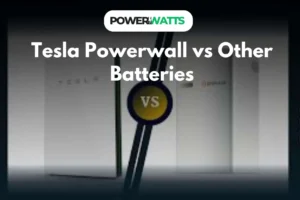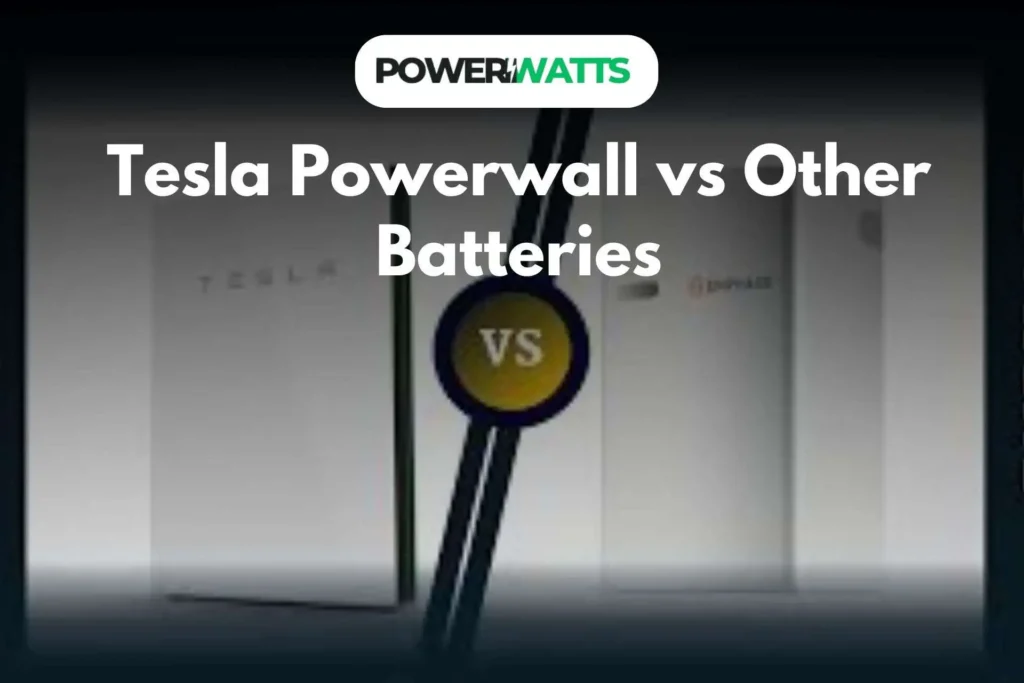Which is the best tesla powerwall vs other batteries? Upcoming renewable systems of energy have made energy storage solutions, including solar batteries, an integral part of the living and business processes of common home and business owners who want to improve the efficiency of their solar power systems further.
Among the many options available, the Tesla Powerwall stands out in the queue due to its stylish design, highly advanced technology, and brand reputation.
However, several other batteries come with certain features and some really compelling advantages that rival or complement the Tesla Powerwall.
As such, this paper will extensively make comparisons between Tesla Powerwall and other popular solar batteries in terms of certain key factors like capacity, efficiency, cost, installation, and overall performance.

Overview of the Tesla Powerwall
The Tesla Powerwall is arguably one of the most recognized names when it comes to residential energy storage. Critics have celebrated its high energy capacity, sleek design, and seamless integration with Tesla’s other energy products, such as solar panels and the Tesla app. Here’s a brief rundown of some of its key features:
Capacity and Power:
- Energy Capacity: Tesla Powerwall 2 offers 13.5 kWh of usable capacity, one of the higher-capacity batteries on the market. This capacity will let the homeowners store a significant amount of energy that can be utilized during peak hours, power outages, or even at night.
- Power Output: The Powerwall 2 has a power output of 5 kW continuous and 7 kW peak. That means it can carry quite a substantial quantum of load, powering many appliances and systems at one time.
Efficiency:
The Powerwall 2 has a round-trip efficiency of about 90%, meaning that 90% of the energy stored in the battery can be used. Competitive in the market to ensure that at least an amount of energy will be lost during the charging and discharging process.
Integration and Compatibility:
The Tesla Powerwall is designed to seamlessly integrate with Tesla solar panels and the Tesla app for real-time monitoring and control. It can also be combined with as many Powerwalls to maximize desired storage capacity.
4Design and Installation:
Besides the fact that it has a wall-mounted design that is sleek, aesthetic, and space-saving, Powerwall has been designed in such a way that installation has been very easy, either inside or outside a house.
Cost:
Tesla’s Powerwall 2 is an installed $11,500 or so, putting it into the upper bracket of choices available for home systems. Keeping this fact in mind, features of the Powerwall brand reliability and possible energy savings make it worth the cost to many users.
Tesla Powerwall vs Other Batteries
Though Tesla Powerwall is a leading option, some of the solar batteries come with options that might interest the end-user with greater features and benefits. Let’s look at some of the finest options, which are contemporaries:
LG Chem RESU
The LG Chem RESU is also sold in several different capacities; one of the most popular models is the RESU 10H, with 9.8 kWh of usable capacity. The RESU10H provides 5 kW of continuous power output, just like the Powerwall
Efficiency:
Whereas the LG Chem RESU10H has a round-trip efficiency of about 95%, hence a little more efficient than the Powerwall 2, meaning that a higher amount of energy will be usable from the reserves stored inside it, thus probably offering even better overall performance.
Design and Installation:
The RESU 10H model is compact, wall-mounted, and can be installed indoors and outdoors. It’s known to be effortlessly integrated with most inverters, therefore being pretty flexible for different solar setups.
- Cost:
The LG Chem RESU10H costs roughly in the ballpark of $7,000 to $8,000 sans installation. This relatively lower cost compared to the Powerwall makes it quite appealing for budget-conscious users.
Enphase Charge
- Capacity and Power:
The Enphase Encharge system is modular, allowing users to tailor their energy storage needs. Each Encharge 10 model offers 10.08 kWh of capacity and a power output of 3.84 kW. - Efficiency:
The Enphase Encharge boasts one of the highest round-trip efficiencies at about 96% in the industry to ensure that only a small amount of energy is lost. - Modularity and Scalability:
Another major advantage of the Enphase Encharge is its modularity feature: one can start with a small system and add more modules according to their needs, offering flexibility and scalability when energy needs grow.
Design and Installation:
The Encharge system is designed to operate seamlessly with Enphase microinverters and Enphase Energy Management Technology. If the customers already have Enphase solar products in their homes, it is a reliable choice.
- Cost: The price of the Enphase Encharge 10 is about $8,000 to $10,000, not including installation costs. Because of the modular design, overall costs would vary depending on the system size.
Sonnen Eco
- Capacity and Power:
The Sonnen Eco comes in an array of sizes, from 4 kWh to 16 kWh, one of the most varied available. In turn, the 10 kWh model has a continuous power output of 4.6 kW. - Efficiency:
The round-trip efficiency of the Sonnen Eco is roughly 90%, just like Tesla’s Powerwall. Performance is very reliable, though not quite as high as some competition, such as Enphase. - Eco-friendly Design:
This is what makes Sonnen committed to sustainability by using eco-friendly materials and offering a longer life span compared to many competitors. The Sonnen Eco is designed for up to 10,000 cycles, which can actually mean 20 years of use.
Integration and Smart Features:
The Sonnen Eco has the capability to integrate into the Sonnen Community, whereby users are able to distribute excess energy to others. This makes this facility even more crucial in increasing energy independence. It also offers smart home integration, making it far more high-tech for energy management.
- Cost:
These pricier options are the Sonnen Eco, starting at approximately $10,000 to upwards of $20,000 depending on the model and installation. Perhaps for some users, the super long life span and smart features can justify this price level.
4. BYD Battery Box
- Capacity and Power: BYD Battery-Box: 3.5 to 22.1 kWh – The BYD Battery-Box ranges from 3.5 to 22.1 kWh with its model, the Battery-Box Premium HVM. This makes it very suitable for users whose energy storage requirements are on the higher side.
- Efficiency:
BYD Battery-Box boasts an approximate round-trip efficiency of 96%, the best in the market. The outstanding efficiency will ensure very good usage and minimum loss. - Scalability:
BYD Battery-Box has designed the product to be highly scalable, with the ability to easily expand storage capacity. Ideal for customers who future-proof their energy storage. - Design and Installation:
First, the Battery Box is easy to install and integrate with the diversity of solar inverters. It is also suitable for residential and commercial use, thus versatile in deployment. - Cost: In general, the pricing will be quite competitive for the BYD Battery Box, and different models and capacities change the price. It generally starts at $7,000 and goes as high as $15,000, depending on the budget of the consumer and energy needs.
Things to Consider When Picking a Solar Battery
When weighing up Tesla Powerwall against other solar batteries, here are the key aspects you should consider:
Energy Needs:
Estimation of required capacity: Assess your energy consumption pattern to estimate the required capacity. If your energy needs are very high, then the BYD Battery Box can be used with a higher capacity.
Budget:
While the Tesla Powerwall is feature-rich, it comes at a price. If you are looking for something more budget-friendly, then consider the LG Chem RESU or the BYD Battery Box.
Integration:
Test if it’s compatible with your current solar or if it needs special inverters and other accessories; for example, the Enphase Encharge is the perfect match if you use Enphase microinverters.
Efficiency:
The more efficient the battery, the more usable energy you get stored, which in turn reduces your overall cost of energy. Among the most highly efficient batteries are the Enphase Encharge and BYD Battery-Box.
Conclusion
The Tesla Powerwall leads among the popular options for solar energy storage with its mix of capacity and efficiency, paired with seamless integration with Tesla products.
It’s not the only choice out there, though, as other solar batteries like the LG Chem RESU, Enphase Encharge, Sonnen Eco, and BYD Battery-Box are rival features that may better suit different needs and budgets.
While choosing a solar battery, consideration must be given to the energy requirements, budget, and the existing setup of the solar panel.
You may come up with the best solar battery, offering the best facilitation to energy independence and value-for-money return on the solar investment you have made, by a simple comparison of features, costs, and benefits each has to offer.
Get a Quote In case you are interested in integrating an inverter with a solar charger into your power system, do not hesitate to contact us today for your custom quote.


